January 8, 2024
20+ Best Slack Apps and Integrations in 2024
Our team has been together for over 10 years, using Slack for a large part of that time. With this experience...
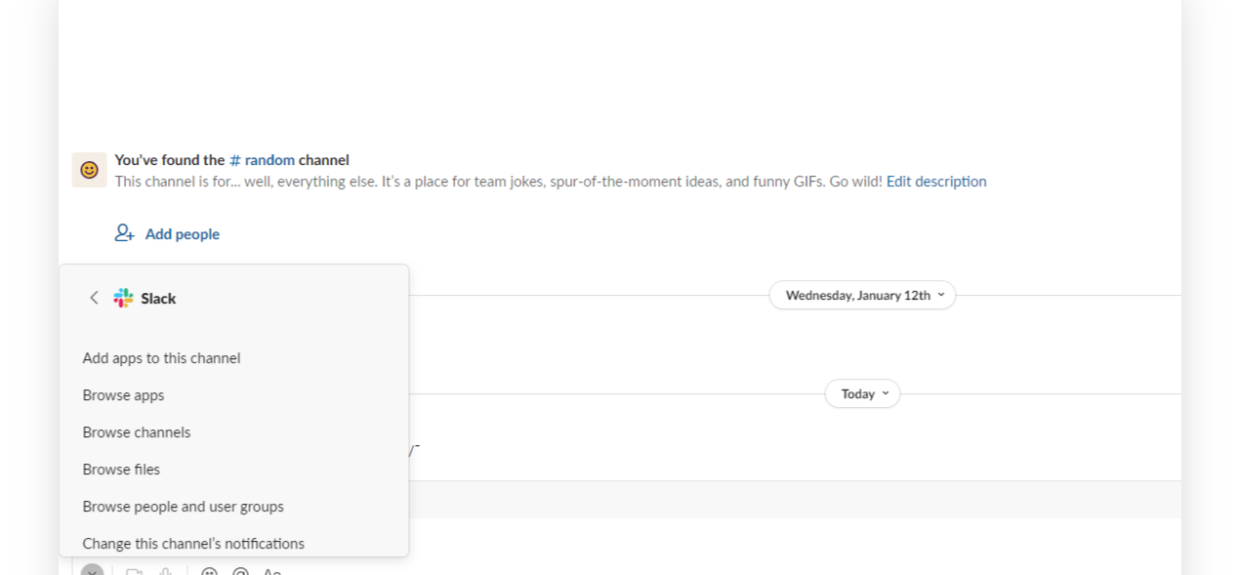
If you’re one of the 12 million people who use Slack for work, it will benefit you to learn a few tips, tricks and useful hacks to start using Slack as efficiently as possible. Slack slash commands are at the top of that list.
Slash commands are one of the things that make Slack such an amazing virtual workspace. These quick shortcuts for basic actions help you speed up your workflow, and get more done in your day.
You wouldn’t think that it makes a big difference, but it does. Even just a few seconds spent moving your mouse, instead of using a quick keyboard shortcut or entering a slash command, adds up to a lot of wasted time over the course of your day, week, your month – or even your year.
Let’s look now at a list of Slack slash commands that are sure to boost your productivity. A slash command is something you type into the message box in a Slack channel or direct message – a forward slash (/) followed by a specific action.
If you do any of these actions regularly, get yourself into the habit of using the Slack command instead.
Soon, it will be something that’s subconscious – like hitting Ctrl+S when you’re writing a document, or Alt-Tab to switch between windows.
These commands work both on your desktop or mobile device – they’re a great quality of life improvement when you’re working on a mobile device.
On to the list!
If you need to switch off to focus on work for a bit, you want to let your teammates know, so you’re not getting constantly hit up with distracting messages.
To do this, set your status to “away”. This removes the little green dot next to your image, which indicates that you’re active in Slack.

Type the slash command /away into any message bar to change your status in seconds.
When you’re ready to show as active again, use the slash command /active.
Quick tip – /away and /active work as toggles – you actually only need to use one of these Slack commands to switch back and forth between statuses. Using /active when you’re already active will set your status to away, and the same with /away.
When you really need to switch off, setting yourself to away isn’t quite enough. You still might get people messaging you, thinking you’ll just respond when you’re back, or get pings from channel notifications.
Type /dnd to put yourself in Do No Disturb mode. During this time, you’ll pause all notifications, allowing you to really focus without distractions from Slack. Just put in the length of time you want to pause Slack notifications for, and it will automatically turn off DND mode when this time is over.
You can also add “for” or “until” after the command and quickly set how long you want to pause notifications.
You can set DND mode for a set period of time, like this:
/dnd for 10 minutes
Or you can set it to turn off at a specific time by adding “until”:
/dnd until 2:00
/dnd until tomorrow

Hit /dnd again to resume notifications straight away.
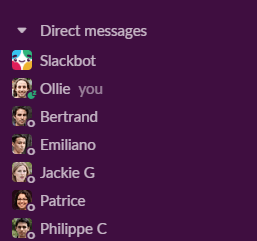
It will show a little sleep icon next to your picture, to show people that you’ve got notifications paused. By default, it will still show you as active though, so you might want to hit the /away slash command as well.
Use the slash command /status to set a more exact status than just “active” or “away”.
This will bring up the “Set a status” popup, where you can choose one of the default statuses for your workplace (by default, things like “In a meeting” or “Out sick”), or set your own custom status.

You can skip the popup and add your status update directly in the message bar, too. Just type /status followed by the status message. E.g:
/status in a meeting
/status out to lunch
You can even add an emoji to set the emoji icon that shows next to your name in the left sidebar. E.g:
/status 😴
/status ☕️ on a coffee break
Learn More:
Slack reminders are such a great productivity tool. You can set reminders to help you or others remember tasks that are due, remind you to come back to a message or task when your current task is done, build a daily to-do list in Slack, and much more.
Use /remind to quickly set a reminder from anywhere. You can bring up the reminder popup from this, or just type out your own reminder syntax.
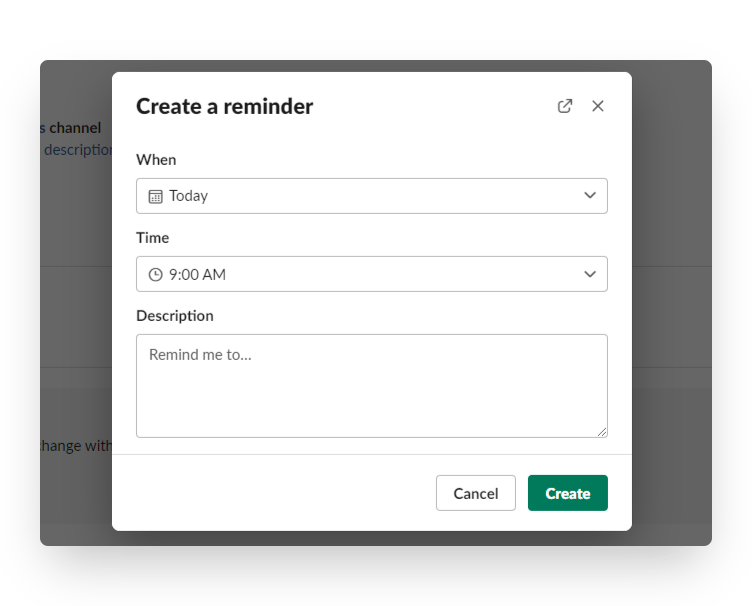

I mentioned the reminder syntax a moment ago. Not sure how to word your reminder command? There’s a command for that too.
Type /remind help for a list of examples of how you can set up a reminder with a simple Slack command.
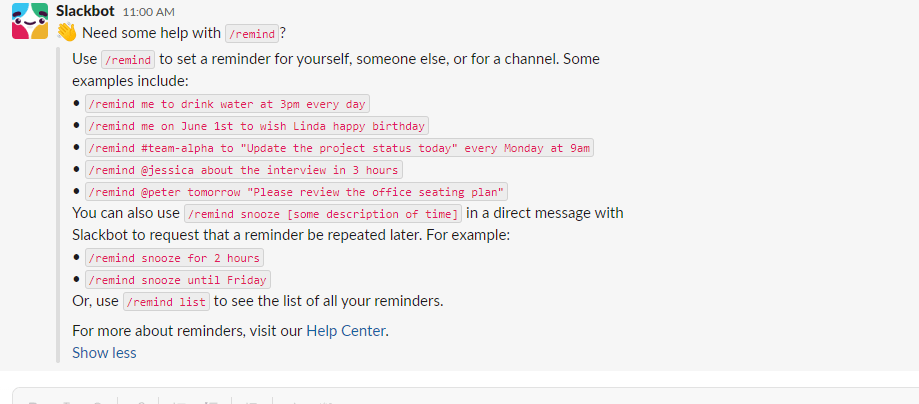
This includes setting reminders for yourself, for individual people, or for an entire Slack channel. You can set recurring reminders, or one-offs.
Using the reminders feature will free up a huge amount of headspace for you, which helps you focus on more important tasks.
One final thing you’ll want to know in regards to reminders is /remind list. This brings up a list of all your reminders – past, incomplete and complete.
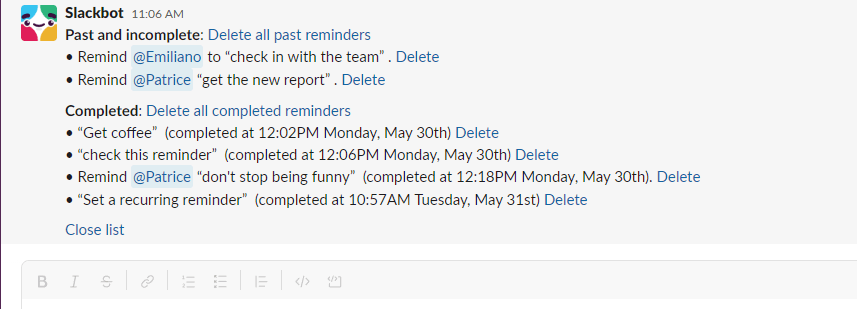
This is great for using reminders for yourself as a to-do list. Just bring up the reminders list at any time to see what you’ve got left to do, and mark tasks as complete to check them off the list.
Slack’s search function is something many people (including myself) don’t utilize to its full potential.
Slack search can help you find that message you meant to respond to, but has since been buried in some channel you can’t remember, or that link that you forgot who posted, and where.
Use /search to start a search instantly. Hit enter to bring up the search bar, or if you know the parameters of your search already, you can type this in directly in the message input.
Some search parameters you can use are:
Slack keyboard shortcuts are the sibling of Slack slash commands. They’re a way to speed up your workflow in a big way.
Shortcuts are even quicker than a Slack slash command, since there’s a tiny bit less typing involved.
If you’re curious what the shortcut is for an action, type /shortcuts. This will bring up the list of available shortcuts on the right side of your screen. Find the one you need, and use it until it’s committed to muscle memory.
Use the /msg slash command to quickly post to any Slack channel or send direct messages to people from your Slack team.
After /msg, type the destination (@[person] or #[channel]), followed by the message, and hit enter. It will take you straight to the conversation. If you’ve got a lot of members and/or channels in your organization, you’ll save a huge amount of time with this Slack command.
You can also use /dm to send Slack messages. It’s one more step than the previous command – you’ll come to a screen where you’ll search for channel name or recipient, and then you type your message.
It’s less efficient than using /msg, but may be useful if you can’t remember the exact channel or person’s name.
/dm can also be used for a couple of other things. Before you hit enter, using the arrow keys you can either jump to all your direct messages, or toggle dark mode on/off (I’m fully aware this might be the most used slash command from this post for many people).
When messaging isn’t enough, use the /call slash command to begin a call. You’ll need to be on the direct message thread for the person you want to call, first. Then just type the command, hit enter and the call will start.
If you’re on a paid workspace, you can also use /call to start a group call in your current channel. Type the Slack slash command and hit enter, and you’ll start a call that all members of the channel can join.
Jump around from channel to channel easily with /open. Type the command, followed by #[channel], or @[person], to automatically flick to the specified channel/direct message thread. This is great if you’re bouncing back and forth between conversations in different Slack channels or direct messages – you’ll end up saving a lot of time by not needing to click on each channel to switch.
Slack automatically shows things like images, videos and link previews with Slack messages. This can get overwhelming, especially when there are a lot of links posted at once.
Use /collapse to minimize all these files and only show plain text (you can still click on files to manually expand them – they’re just hidden by default).
If you had used /collapse earlier, but now want to revert back, type /expand in the message box to bring back all images, videos and link previews.
Sometimes you need to stay part of a channel, but it’s no longer relevant when there’s a new message in that channel. Notifications and new message indicators can be quite distracting in this case.
Use /mute to mute the channel. This will move it to the bottom of your channel list in the sidebar, and no longer send you notifications or show up as an unread channel when there’s a new message. You can still participate in the channel though.
Type /mute again to unmute the channel and revert it back to normal.
If you’re doing a bit of channel cleanup in your organization, use /archive to close a channel.

This will remove it from the channel sidebar, and block any new activity. The channel history will still remain though, so people can search and view messages from the channel, and unarchive if it needs to be restored.
If you don’t need to be in a channel anymore, type /leave to gracefully exit.
Think about whether you need to use /leave, or if the /mute slash command would work just as well. If you choose to leave a private channel, you’ll need to be invited back in if you want to re-join at any time.
If you want to know who’s a part of the channel you’re in, type /who. Our friendly Slackbot will send you a list of all the members of this particular channel.

Type /invite to quickly add someone to a channel. Search and find their name from the list of people in your workspace, or add them via their email address.
The /invite_people command is for when you want to add people to your Slack organization. Type it out, hit enter, and you’ll get a popup where you can enter their email to send them an invite. You can also copy the invite link here, and share it with whoever you want to join your workspace.
To quickly remove someone from a channel, use /remove. Type the slash command, followed by @[person].
This works just like /leave (for the person in question). They’ll be able to join it again if it’s a public channel. If it’s a private channel they will need to be invited to re-join.
Further Reading:
Type /apps to quickly manage your Slack apps and integrations. Type the slash command, and using the arrow keys you can choose apps to add to the channel you’re in, or jump to the “Browse Apps” screen.
Here, you can check out the installed apps on your workspace, add a number of popular or featured apps, or click through to the Slack App Directory to browse and view more third-party apps.
/me is a way to format your text as “action text” – which is realistically just italics.
Most people will be more familiar with, and find it easier to use Ctrl/Cmd+I (the basic italics hotkey on any computer), but if you enjoy the /me Slack slash command, you do you.
Okay, this one is pretty cool though. Type /shrug, followed by your message, to automatically add the shrug guy to the end of your image.
This one: ¯\_(ツ)_/¯

This is a fun way to add a little flair to your messages. Just don’t do it when you’re being grilled by your boss, or someone mentioned that their cat just died.
The list above are all built-in slash commands that come with any workspace. But third-party apps may have their own slash commands too, and you’ll want to learn and use these.
For example, with the Zoom app, type /zoom followed by help, meeting, join or call, to jump to each action quickly within Slack.
The Google Calendar app is another useful one when it comes to slash commands – type /gcal [today][tomorrow][settings] to check in on and manage your Google calendar within Slack.
To check on the slash commands for any app you use, go to its App Directory page, and go to the “Features” tab. This will give you a list of all slash commands you can use with this app.
It was only recently when I learned that the most productive people all use shortcuts or hotkeys. I was talking to a friend who is an extremely successful UI/UX designer, who said that shortcuts were absolutely essential for his workflow.
It doesn’t seem like much to use a shortcut, hotkey or Slack slash command instead of doing an action manually, but it adds up to a lot over your day. Learning simple shortcuts, like slash commands, really speeds up your workflow, and helps you jump from task to task smoothly.
If you’re someone who spends a lot of your day on Slack, you need to learn some basic slash commands. You may not need to know all, but even just one or two that you use everyday will make a huge difference to your productivity.
Flamingo makes managing your team’s paid time off a breeze.